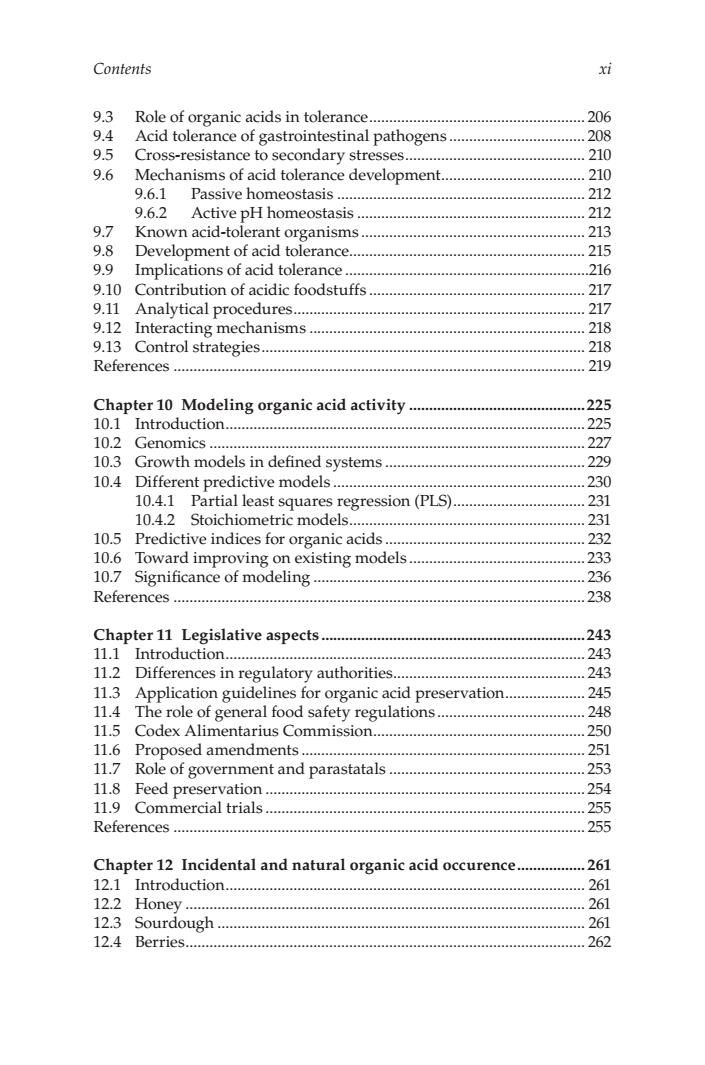正在加载图片...

Contents 93 Role of organic acids in tolera 20e 94 Acid tole 9.5 stinal pathogens 208 ondary stres 2 9.6 chanisms of acid tolerance development. 210 9.0.1 Passive homeostasis 213 9.6.2 Active pH homeostasis 212 Known acid-tolerant organisms 213 Development of acid tolerance. 215 9.9 Implications of acid tolerance. 216 9.10 Contribution of acidic foodstuffs 21 9.11 Analytical procedures. 217 9.12 Interacting mechanisms.. 21只 9.13 Control strategies. )18 References 219 Introduction. 225 22> 10.3 Growth models in defined systems. 9 10.4 Different predictive models.... 20 10.4.1 Partial least squares regression(PLS).. .231 10.4.2 Stoichiometric models.. .231 10.5 Predictive indices for organic acids.. 232 10.6 Toward improving on existing models 233 10.7 Significance of modeling.... .236 References 238 Chapter 11 Legislative aspects 43 111 Introduction 243 11.2 Differences 24 ation guidelines for organic acid preservation. 11.4 The role of general food safety regulations.... 11.5 Codex Alimentarius Commission. 250 116 Proposed amendments.... 25 11.7 Role of government and parastatals............ ,.253 11.8 Feed preservation.. .254 11.9 Commercial trials .255 References」 .255 Chapter 12 Incidental and natural organic acid occurence .261 121 ntroduction 261 Honey 261 ugh 261 Berries.. 262Contents xi 9.3 Role of organic acids in tolerance...................................................... 206 9.4 Acid tolerance of gastrointestinal pathogens .................................. 208 9.5 Cross-resistance to secondary stresses............................................. 210 9.6 Mechanisms of acid tolerance development.................................... 210 9.6.1 Passive homeostasis .............................................................. 212 9.6.2 Active pH homeostasis ......................................................... 212 9.7 Known acid-tolerant organisms ........................................................ 213 9.8 Development of acid tolerance........................................................... 215 9.9 Implications of acid tolerance .............................................................216 9.10 Contribution of acidic foodstuffs ...................................................... 217 9.11 Analytical procedures......................................................................... 217 9.12 Interacting mechanisms ..................................................................... 218 9.13 Control strategies................................................................................. 218 References ....................................................................................................... 219 Chapter Modeling organic acid activity 10 ............................................225 10.1 Introduction.......................................................................................... 225 10.2 Genomics .............................................................................................. 227 10.3 Growth models in defined systems .................................................. 229 10.4 Different predictive models ............................................................... 230 10.4.1 Partial least squares regression (PLS)................................. 231 10.4.2 Stoichiometric models........................................................... 231 10.5 Predictive indices for organic acids .................................................. 232 10.6 Toward improving on existing models ............................................ 233 10.7 Significance of modeling .................................................................... 236 References ....................................................................................................... 238 Chapter Legislative aspects 11 ..................................................................243 11.1 Introduction.......................................................................................... 243 11.2 Differences in regulatory authorities................................................ 243 11.3 Application guidelines for organic acid preservation.................... 245 11.4 The role of general food safety regulations ..................................... 248 11.5 Codex Alimentarius Commission..................................................... 250 11.6 Proposed amendments ....................................................................... 251 11.7 Role of government and parastatals ................................................. 253 11.8 Feed preservation ................................................................................ 254 11.9 Commercial trials ................................................................................ 255 References ....................................................................................................... 255 Chapter Incidental and natural organic acid occurence 12 ................. 261 12.1 Introduction.......................................................................................... 261 12.2 Honey .................................................................................................... 261 12.3 Sourdough ............................................................................................ 261 12.4 Berries.................................................................................................... 262